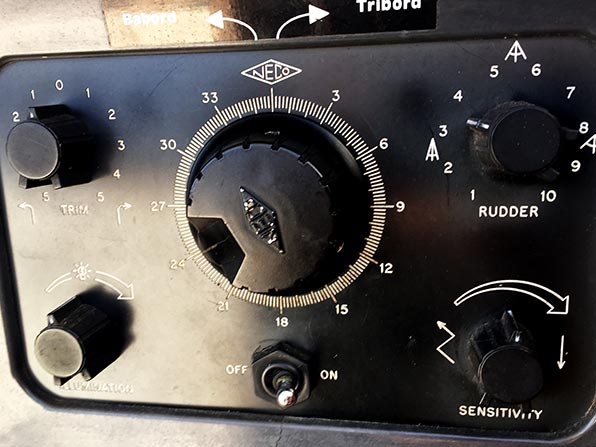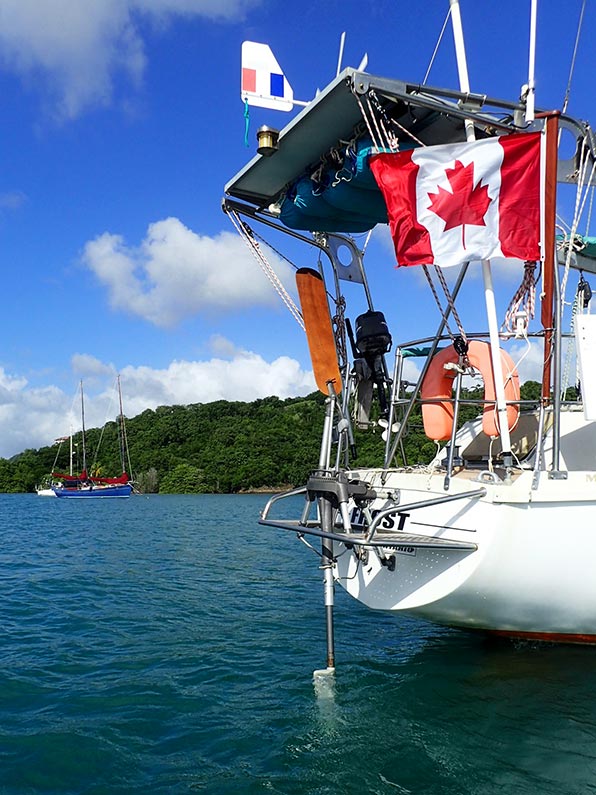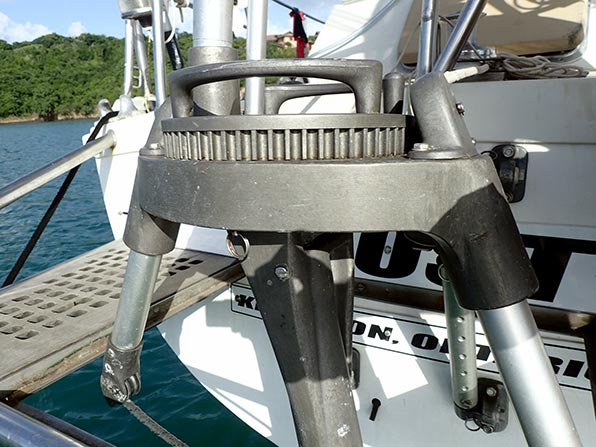A crew member that never gets tired
As fun as it may be to hand steer a boat while out on a daysail, having to do so on a long passage, especially by a short handed crew, is tedious at best. Having a reliable method of self steering is so important that many captains will turn their boats around and return to port if they experience an autopilot failure shortly after beginning a passage.
We experienced an autopilot failure on the Leopard while on a passage to St. Martin, forcing us to hand steer for a little over 10 hours, and I can tell you, it’s tiring. So much so that Rebecca and I changed our watch schedule to two hours on, two hours off, just to give the helmsman more of a break.
Note: Autopilot failures always seem to happen when the conditions are bad, and the loads on the system are high. In our case, we experienced the most intense electrical storm of our sailing career right after the autopilot’s drive chain snapped, and it lasted for over an hour. When lightning is all around you, having your hands on a big metal wheel is not comforting.
Frost has an electronic autopilot and while pretty old-school, it seems quite beefy. The boat also came with a spare for each of the three main components of that autopilot: the motor, control unit and the compass. That’s pretty nice.

One challenge with an electronic autopilot is that they typically take a fair amount of power to run, and some boats, with limited battery banks, find it difficult to keep that power going, especially while sailing at night when their solar panels aren’t charging the battery bank. We have that shaft alternator that I mentioned before which should help us keep up with the power demands, but not everyone is so equipped.
The other challenge with our autopilot, being old school as I mentioned, is that it is not set up to sail to a wind direction, only a compass course. More modern systems, integrated with their wind sensors, can do both, but ours is not set up that way.
A solution to both of those issues is to use a self-steering wind vane, of which there are several different models available. While it was not installed at the time we purchased her, Frost came with one of these systems, and we were anxious to check it out.

The blue boat in the background also has an Aries wind vane.
Yesterday, with some nice weather and a bit of time on our hands, Rebecca and I dug out all of the pieces to our Aries wind vane, and worked through the process of installing it. I think one testament to a well-designed product is that you can assemble it without an instructional manual. We were able to do just that. We began the process by removing the center panel of our swim platform to make room for the unit, and I can only surmise that the platform was built after the wind vane was initially installed as the space that the removed panel left fit the system exactly.
Once that space was made available, the pieces snapped together solidly. Unlike some other self-steering vanes, the Aries works by turning the actual ship’s wheel (or tiller) via some no-stretch lines. The blocks to lead these lines to the cockpit were already in place making it, again, easy to put together.

Did the system work once we got it all together? Well, that’s hard to say exactly. I can say that it functioned as far as we could see, turning the wheel when we moved the various pieces by hand. We didn’t take the boat out sailing though to really test its operation, and we removed the vane shortly after we were done with that initial testing.
Why would we do that? The problem for us with leaving the vane on the boat is that with it there, we would be unable to raise our dinghy on the davits. On an ocean passage, that wouldn’t be a problem as we have no intention of carrying the tender there but around here, we always have the dinghy in the davits when under way.



Funny you should mention that.
Yesterday I was out in a nice breeze, alone, started a tack… and the pilot locked. We did 3 tacks and 2 jibes, carving tight circle, before I could remove the autopilot. Either I looked like a racer practicing penalty turns or a damn fool. I was also glad it was not blowing too hard; that could have been dangerous. The moral is to make certain you know how to take it off completely in short order; the release button or lever can fail.
A tiny broken plastic part, easily repaired better than new with a small bolt. It was time for a new belt anyway.
Wow. That is a funny coincidence. I’m not sure how I’d go about disengaging ours. I’d better find out.
Mike – along the way across the South Pacific, I met two different cruisers who had both rounded Cape Horn (and didn’t know one another). Both of them experienced “compass” problems in the extreme Southern latitudes. With one cruiser, his binnacle compass started to “stick” and eventually remained stuck until he got to NZ and had it repaired. With the other cruiser, both his binnacle and flux-gate compass failed intermittently. Of course, the flux-gate was a reference for the autopilot. He had to make a jury rig repair, underway (enroute to Easter Island), where he placed a magnet “near” the flux-gate sensor and then steered off course by about 90 degrees in order to keep going in the right direction but away from the “sticking” point of the flux-gate sensor. Maybe you should consider adding “investigate potential compass sticking in extreme Southern latitudes” to your list of things to do, or at least be prepared with alternatives. Of course, if you can get your self-steering gear to the reliable stage, then you’re covered……
I actually just read something about that in the book “My Old Man and the Sea.” I don’t remember the exact details but they said something about the compasses on our boats are set up for the northern hemisphere and that when used that far south, they are always off. The repair had something to do with adding a magnet to the compass. So yes, I guess that is worth investigating!
While reading this post I did jump over to the link “shaft alternator” and am curious about the noise produced while rotating. Is it really noticeable over the wind and waves??
Not at all.